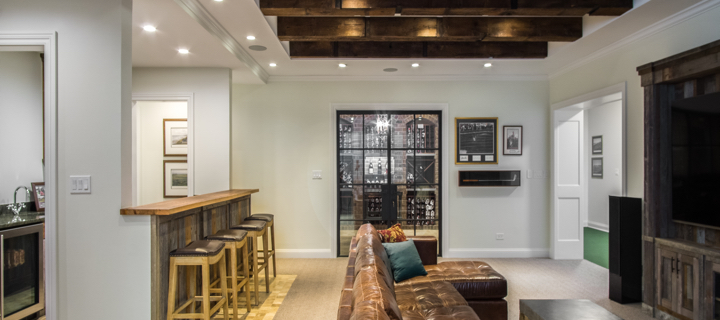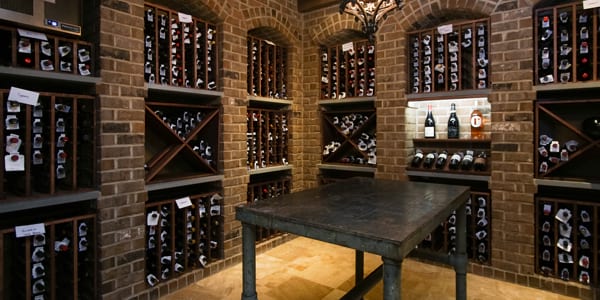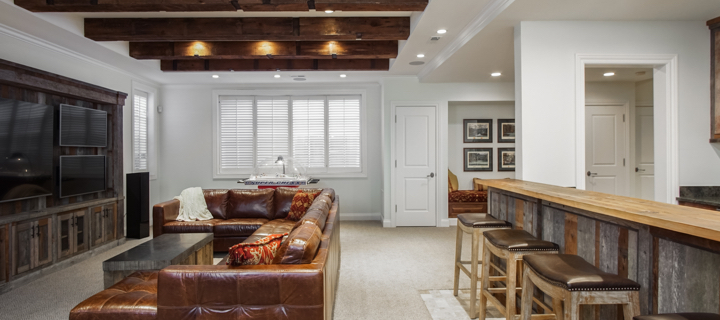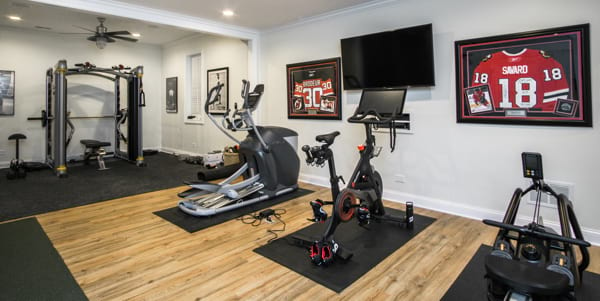Everything you Need to Know About Basement Conversion for Your Home

Converting your basement into usable living space is gaining popularity, as is excavating under the home to create a basement for any number of uses. Homeowners are faced with decisions when it comes to a home improvement project. Some build up. Others build out. An excellent alternative is to build/renovate down. However, you might be wondering if your home is a good candidate for such a project.
There is no doubt that a basement conversion is a big project; probably one of the largest a homeowner will face aside from a whole home renovation. Consider the following information to help you make your decision about whether or not to pursue a basement conversion.
Why convert your basement and how long does it take?
“Down is the new up!” It’s a phrase you’ll see if you spend any time researching a basement conversion project. Nobody wants to be displaced by a major construction project for a lengthy period, so the second thing you’re probably searching for is how long a basement conversion will take. As you might have guessed, that depends on the scope of your project. Are you digging out a basement or simply doing an extensive remodel.
By most accounts, barring any unforeseen hurdles, a small conversion can take around four weeks. More extensive projects that involve excavating earth can take months, perhaps as long as five months for the most demanding projects.
You also have to consider the materials you want to include in the project: Will they need to be custom built, or are the materials you want rare? If so, this could impact the timeline.
A careful planning process, which begins with your vision of what you expect the project to look like upon completion, working closely with your designer and maintaining excellent communication with your contractor are all important aspects of the project. Careful planning and staying true to your plans will help keep you on your deadline.
The pros and cons of basement conversions
The pros of converting your basement are fairly obvious and straightforward – you get a new space in which you can do whatever it is that you designed it to be used for. From a home gym to an entertainment area to new bedrooms or playrooms for the kids – you are only limited by your imagination.

Another perk is that if you decide to sell, having a finished basement will be attractive to almost any homebuyer, reducing your time on the market and giving you a better chance at getting asking price.
One of the biggest cons of a basement remodel includes the cost, especially if it involves moving earth, installing waterproofing and doing extensive foundation work. Even if you’re renovating an existing basement, you still have to contend with ventilation and plumbing, which adds time and money to the project.
Furthermore, if you live in an area that is prone to flooding, or if your water table is high, you will have to put into place solutions that will prevent water from rising in your home during the rainy season or when snow melts off.
There is also the time consideration that many homeowners consider a con. Construction projects can be time consuming, especially if your basement is particularly complex to convert. If you’re not a fan of the noise and clutter of construction, you’re going to see this as a con, too.
Is your basement suitable for a conversion? (things to consider)
Not every home is going to be a good fit for a basement. For example, is your home’s foundation directly on top of bedrock? Digging through that might be so cost prohibitive that you have to build out or up instead. Here are some considerations for determining if your home is a good candidate:
House Type
An old Victorian home might not seem up to the project, but because most of these house types are sitting atop suspended timber floors, it actually makes them ideal for a conversion because contractors can easily secure timber floors.
If your home has a shallow foundation, contractors are almost always able to secure the structure so they can safely work under the home. The caveat seems to fall on townhomes and houses that are built on raft foundations. These cannot be secured properly, meaning your contractor won’t safely be able to carry out a conversion.
Spaces
Space is a major consideration in whether or not you can go ahead with your basement project.
If you need extra plumbing, do you have space for it? Is there space for proper ventilation? Do you have space for heating and cooling ducts or appliances? Will the electrician have space to meet the demand for all your electrical needs?
Working with your design-build contractor will help to determine if space issues will impede your basement project.
Building access
You’ll need access for machinery and mechanical gear to get in and out of your basement, so that’s going to be a big consideration.
For homeowners without an existing basement, you’ll also have to think about how the large excavating equipment will work around your neighbors’ homes and if there will be access for them to remove the earth under your home.
Furthermore, will there be a suitable area on the landing floor for stairs? These issues can be a limitation for smaller homes and homes built too closely to neighboring houses.
Walls and foundations
Every successful basement renovation or conversion is based on the quality of the walls and foundations. This is due mostly to the fact that water is the enemy of just about any basement project.
The foundation serves multiple services – it secures the basement and everything above it. The walls of your basement serve as the second line of defense against water.
Contractors will determine your needs and ensure you get the right foundation and wall material type to keep your basement bone dry.
Dampness
You might not have been familiar with the phrase “rising damp” until you began researching basement conversions, but to put it simply, damp rising occurs when moisture comes up from the ground and travels through the walls. This can be prevented with a “damp-proof course,” or DPC. It’s basically a barrier that is designed to stop the water from penetrating your walls.
Waterproofing
The greatest threat to your basement is water, and because water takes the path of least resistance, and because gravity takes it to the lowest possible point, your basement will be the catchall for any excessive water. Waterproofing is a must. This involves preparing the walls to combat water on the outside, but can also include sloping the ground so water runs away from the home.
Further measures, such as installing French drains, can also keep water moving in the right direction – away from your basement interiors.
Lighting
You don’t want a dark and gloomy basement, so the best fit for a basement conversion is one that is partially sub-grade, which means you’ll have room for windows that let in natural light.
If you don’t have this option, work with your designer on a lighting scheme that will keep the basement nicely lit.
Ventilating
Basements are known to be musty, which is caused by damp air that has no means to escape. It might seem like a problem if you rarely go into your basement, but when you plan on spending substantial time there following a conversion, you must consider ventilation.
A reversing fan is often installed to bring fresh air from the inside so there is a constant flow that takes moisture away, reducing the chance for a musty aroma to build up. This fresh air is also important to appliances commonly installed in basements, including gas water heaters, furnaces and boilers.
Dehumidifiers are also a common go-to method of reducing moisture in the air and they can also help to produce positive airflow.
Insulation
Most building codes require that R-11 insulation be installed in the basement. Despite the fact that most basements are at least partially below ground, they do experience heat loss, which is why you want to insulate the walls. It’s not advised to use rigid foam on stone or mortar walls; rather, use closed-cell spray polyurethane foam as it works best on these type of walls.
Heating
There are several heating options in a basement conversion. Radiant floor heating is a popular choice, as it will keep your feet warm and the rising heat will naturally warm up the basement. Furthermore, that heat will rise to the upper levels, which should help you maintain lower utility bills in the winter.
You can also extend the HVAC ducts to registers in your basement, add a stand-alone system, such as a pellet stove, or have an infrared heater installed. Talk to your designer-build contractor about the various options and choose what fits your tastes and your budget.
Converting your basement space
Some basements are partially finished while others are no more than a space with dirt floors. Others are non-existent or have ceilings too low to provide suitable space, in which case excavation will be necessary.

-
Simple cellar conversions
Cellars are often considered small, damp and unfinished sub-grade rooms. They are often far more enclosed than a basement, but can sometimes be attached to basements. If you’re currently storing wine in your cellar and want to convert it into livable space, you’ll have to make sure you can get airflow in the area to reduce moisture and the musty smell that comes with it. While cellar conversions are usually less involved than basement conversions, you’ll still need to work with an architect to make sure it is structurally sound as a livable space and that there is enough room available for what you want to do there.
-
Structural basement conversions
Excavating underground is not a quick and easy project, which means you’ll need to hire a contractor with experience taking on a structural basement conversion. This requires survey work to determine what the ground structure under your home. If the survey comes back positive, you’ll need to hire an architect to make sure all the structural elements are there to protect the rest of the home, such as a temporary support structure and a permanent foundation. The entire home rests on the foundation, which means any structural issue not accounted for could result in catastrophe.
Working with a qualified design-build contractor is the go-to solution for these types of conversions. They have the expertise within one company to attack every phase of the project.
Tips for converting your basement
When taking on such a complex project, it pays to think about all the possibilities well in advance. The following are some of the best pre-planning tips you should consider:
Anything 6.5 feet below ground level is considered a basement. If you’ve got a “semi-basement,” it’s a basement floor level that is around 3.25 feet below any adjoining ground. If your home is on a slope, you’ll probably see variations in the levels. For example, some homes will have a basement completely underground on one side, yet as the slope graduates, you could have enough space to build an entrance to the basement (option only applies if you have an existing basement, in most cases). The options for how you approach the design of your basement will depend on your unique situation.
A proper basement has enough ceiling height to ensure you can move about freely and that any tall members of the family aren’t bumping their heads on anything. Unfortunately, high water tables can impact how low you can dig. Also, clay and bedrock can pose significant issues that result in higher cost for excavation.
For existing basements, rarely will a municipality require you to gain planning permission to continue with your project. The story is different for projects that alter the existing appearance of your structure, which will require some communication between you and/or your contractor and your governing body.
Different municipalities have different codes, which means to plan your basement conversion, you need to be sure you’re following all the rules. Contact your building permit office and tell them about your project and you’ll get a list of all the different permits you’ll need to proceed legally and by code.
A well-devised budget can keep you from experiencing any financial stress during your project. Make sure you budget allows for unforeseen expenses, because just as in any construction project, “surprises” are inevitable and you want to be prepared to meet it head on.
Don’t risk upsetting your neighbors – let them know you’re embarking on a construction project and give them an idea of what time of day it will begin, end and how long the project is expected to last. This is just a courtesy that can smooth them over should they be bothered by potential noise and/or clutter.
Before you get too involved in planning for your basement conversion, contact a design-build contractor to ensure your home is suitable for a basement conversion. A design-build contract has experts on staff that can help you with your vision, but just as importantly, the construction side of the team will thoroughly inspect your space and make a judgment on whether or not the project can proceed.
As a complex project, basement conversions require a lot of thinking ahead of time. With the right amount of planning and by sticking to the rules and your budget, it’s going to be much less complex.
Do basement conversions add value to your property?
Yes! Because you’re increasing the amount of livable space in your home, you will increase your home’s resale value. Keep in mind that if you go all out and spend a lot of money on your conversion, it will impact your return on investment.

Another thing to consider is that if few homes in your neighborhood have basements or have basements that are unfinished, the fact that yours is move-in ready will help you sell faster and perhaps even sell for more than the other houses in your area.
How much does a basement conversion cost?
There are a variety of factors that will determine the cost of your conversion. This includes everything from the square footage of your basement to the materials you use to the type of new basement you’re creating. Here are several factors that will increase the cost of your conversion:
- A high water table that requires advanced plumbing
- Poor site access
- Re-routing drainage pipes
- A house on marshy land, clay or bedrock
At New Concept 180, our experience with clients has shown that the average basement conversion will cost between $30,000 and $70,000. More extensive projects can cost up to $100,000.
It all starts with the budget. To get a better idea about what your project will cost, start by considering how many rooms and what type of rooms you want to include. Next, consider how you’ll outfit these rooms – think of everything from your lighting (LED lighting, etc.) and wall details, because every element of the project will influence your overall budget, and the dictates selections and possibilities. If you want to add a bathroom, sauna, steam room, massage/spa area, wine cellar, bar, movie theater, play room, golf simulator, weight room – these amenities will obviously come at a price.
There are other aspects of the project that can influence cost that can impact your choices for amenities. For example, if you’re installing a bathroom or wet bar, the main water service might need to be upgraded. The size of the pipe for main water service entering the house is calculated on total count of the fixtures being used. Adding new fixtures, such as faucets and toilets, will trigger the need for larger pipes, which can impact the budget by $8,000 to $10,000, depending on the scope of the work.
Furthermore, if you have an older house and earth has to be excavated to provide adequate headspace for a basement, homeowners often don’t consider underground plumbing needs, which can also add to the cost. For example, installing interior drain tile to keep the basement dry is obviously recommended. However, this option will cost $8,000 to $15,000, depending on how many linear feet are required.
Electrical needs are also a consideration that must be part of the pre-project planning. For instance, if you have an unfinished basement, there's a good chance that electrical pipes and heating/cooling ductwork was installed below the basement ceiling joists. Technicians that did this work years ago probably didn't consider that future owners of the home would convert the basement, so they designed their systems with an ease of installation in mind, the end result of which is at odds with a modern basement conversion. That means there is a good chance that those systems need to be reworked to minimize the number of soffits and soffit sizes. This type of work starts $5,000.
Working with your designer-build contractor, you can nail down a solid number that you can plan around. In the end, it all comes down to what a converted basement is worth to you. Spending too much will reduce the chance of you seeing a return on investment should you decide to sell, but that isn’t always the highest consideration for every homeowner.
Basement options
Space is the only thing working against you when it comes to basement options. If you’ve got a lot of square footage to work with, you could consider more elaborate ideas for your new livable space.

The following are some of the more popular trends builders are seeing these days:
-
Guest suite or bedroom
Need extra space for a growing family or for visitors? Guest suites are in vogue. If you’ve got the room, you can include a bedroom, bathroom and kitchen or kitchenette.
-
Home gym
This trend is an ongoing one as America battles its waistline. The basement is actually a perfect spot for gym equipment that seems out of place in any other room in the house.
-
Studio
Music lovers can practice and record in a basement and not really have to worry about the volume bothering the neighbors. Furthermore, the basement can serve as a studio for artists who need a space for their pottery wheel or canvases and anything artsy in between.
-
Theater room
Projection screens, comfortable loungers, maybe even a portable popcorn machine are popular items in basements for families that want to dedicate an area to watching movies and their favorite television programs.
-
“Man” rooms
Does dad need a place to escape? He can trick out the basement in a motif that speaks to his favorite sports teams. Add a pool table, foosball, air hockey or darts and make it a family affair.
-
Playroom
Toy clutter can be a real nuisance. Why not keep it all contained in the basement where you can keep an eye on toddlers and not have to worry about picking up the mess after each play session?
-
Utility room
If you still need storage, but want to include other elements, such as a laundry room, a spare bathroom and a living area, some basements will have the space you need for it.
If you’ve got ideas for your basement but need some guidance, talk to a designer about what’s possible in your space. The area doesn’t have to be dedicated to one specific thing, so if you have ideas for multi-use, it might be completely possible. At New Concept 180, we have options for you to consider. Check out our basement remodeling page and see the services we provide.
Home remodeling experts for your basement conversion project
At New Concept 180, we have assisted many clients in the basement conversion process. We’ve seen just about every type of situation, so we know we can assist you with yours.
The advantage we have over competitors is that we’re a design-build company with all the experts we need to complete your project on time, on budget and to your specifications. Our designers will work with you in the design phase and let you in on the trade secrets so you can stretch your imagination and get the basement you want. Our build team, which includes carpenters, electricians, plumbers, excavators and every other type of tradesman required to finish the job, all work under one roof.
Communication is important in basement renovations, and with NC180’s approach, we put our clients first and keep them in the loop so they always know the progress of the project. Contact us and let’s talk about your project.









